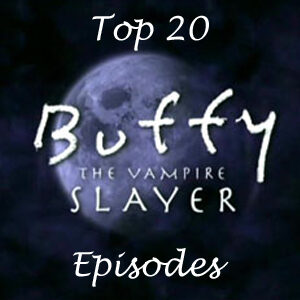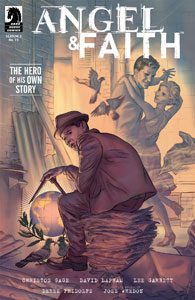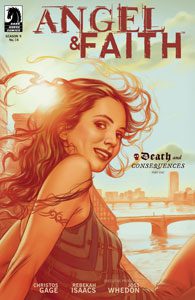The second batch of 10 issues in “Angel & Faith” Season 9 starts with a slight midseason dip in quality. It’s nice to catch up with Connor and Gunn, but distracting for readers of the IDW “Angel” comics who know a different continuity. The last five issues of this batch are gold, though: first the most Ripper-esque Giles story to date, and then a pitch-perfect Faith-and-Spike comedic romp. Here are my reviews of Issues 11-20:
“Family Reunion” (Issues 11-14, June-September 2012)
Before starting on “Angel & Faith,” I would’ve said a catch-up with the Angel Investigations gang – last seen in IDW’s “Angel” — would be crucial to my enjoyment of Season 9. We get it in “Family Reunion,” but it’s irksome that Connor is a college student again and Gunn is watching him from a distance for Angel. In the IDW books, Connor had taken the reins of the LA-based detective agency from Angel and was exploring his next level of superpowers.
Many fans now know that the “Angel” issues post-“After the Fall” are not canonical, but many readers didn’t know that at the time, and some might not know it now. It’s not like the issues in question are stamped “non-canon” on the cover. And even with that knowledge, it’s distracting that Angel and Connor are going through the father-son reconciliation they already covered in the IDW books. Also, while Connor and Gunn had mostly buried the hatchet from their feud by the end of IDW’s run, it’s weird that there’s no residual tension there, or a newly built camaraderie; they’ve gone from fighting side-by-side to barely having a relationship.
Over in the “Buffy” pages, Illyria is likewise coming off non-canon IDW yarns, but it’s not as jarring there because she notes that Angel and company overestimated her unselfishness; that alters the interpretation of her IDW character growth without erasing it. I feel like Christos Gage could’ve made a similarly smooth transition rather than straight-up treading old ground.
Overall, “Family Reunion” is a solid if predictable tale about Willow beginning her quest for magic (to be continued in “Willow: Wonderland”) by starting in Quor’toth, the portal to which can be opened by Connor because he grew up there. The dimension is so steeped in warfare and evil that Willow goes dark, sort of like Angel in Pylea, and Angel helps her back from the brink. Willow, Angel and Faith have a nice “watch each other’s backs in case we turn evil” club going.
I’m a little surprised that Willow’s warning to Angel about the dangers and side effects of resurrecting someone from death only lasts a couple of panels, but at least it’s clear now that Angel knows Buffy did not desire to be resurrected.
Meanwhile in London, Nadira learns that Faith has been working with Angel, and we see that the threat of Pearl and Nash is nothing compared to Whistler, whose innate magic is much more powerful; P&N are merely his lackeys. But what is Whistler’s end game? He talks about maintaining a “balance” (which doesn’t sound so bad), he was Angel’s ally in the past and he claims Angel’s Twilight scheme got out of hand from the original intent. But there’s something about him I don’t trust.

3.5 stars

“The Hero of His Own Story” (Issue 15, October 2012)
This issue gives us the backstories Whistler (in part one) and half-demon siblings Pearl and Nash (in part two). Even with Whistler, the plan’s architect, speaking about the Season 8 Twilight plan, I still don’t totally understand it, and probably never will. I guess it comes down to the fact that Whistler is OK with sacrificing lots of people for the sake of a better world, and Angel thought he was too, but actually was not when it came down to it. Thus, he “threw the game in the ninth inning,” as Whistler angrily puts it.
It’s great to get Whistler’s backstory, though. He was born of a father who was a member of the Powers That Be and a mother who was an evil demon. That inexplicable alliance inspires the Powers to position Whistler as someone who works to keep balance in the universe, using his visions of possible futures to guide him.
Whistler tells Angel that usually he has had to aim for a little more good in the world, because things tend to go bad on their own, and that’s probably why we, as Buffyverse fans, tend to think of him as a good guy. But he’s not. It’s never satisfactorily explained why the PTBs and Whistler are obsessed with balance (the “Star Wars” prequels have a similar problem). Common sense dictates that an imbalance toward good is better than a balance between good and evil. Maybe there’s more information about the value of “balance” to come in later issues, but I doubt it.
Pearl and Nash’s origin story is a nice slice of gothic horror. Like Whistler and Twilight, P&N’s mother is obsessed with the big picture of improving the world. During the Great Depression, she summons a demon to mate with her, thus producing the half-demon twins. For some bizarre reason, she encourages them to then mate with demons, thinking more demon blood will lead to a net improvement in humanity (or what humanity morphs into). P&N actually do produce demon offspring of their own, but humans — including Alasdair Coames, Angel’s London ally in present day — kill them all.
“The Hero of His Own Story” is an entertaining read, even if it doesn’t offer surprises or sympathetic revelations about Season 9’s villains.
4 stars

“Death and Consequences” (Issues 16-19, November 2012-February 2013)
This cracking good four-parter finally shows us Giles’ teenage Ripper period, when he, Ethan Rayne and their friends sell their souls to Eyghon, something that briefly came back to haunt them in “The Dark Age” (“Buffy” 2.8). Although “The Dark Age” is merely an OK episode by Season 2’s high standards, it launches the notion of Giles’ misspent youth – something the TV series didn’t follow up on all that much — as well as a great villain in Eyghon himself, who can possess not only corpses but also unconscious people, thus possibly gaining an exponential edge over the course of a battle.
In the present day, Eyghon has collected what’s owed to him, possessing the bodies of Giles and Ethan as part of an army he’s assembling to turn Earth into a new version of his home dimension (which he can’t return to, thanks to the destruction of the Seed). Gage clicks on all cylinders with his storytelling rhythms, capping Issues 16-18 with great final-panel pop-ins: “Giles” (actually Giles’ body possessed by Eyghon), Eyghon in full demon form, and Spike. Angel needs a second champion who can’t be possessed by Eyghon; vampires already house a demon. Delightfully, Spike doesn’t miss the chance to gloat about how Angel needs his help – and we’d expect nothing less from him.
We learn that in Giles’ Ripper period, his and Ethan’s recklessness results in the death of one of their friends, and that Giles fronts a punk band before being talked into returning to the Watchers’ academy by his grandmother. While she apologizes for driving Giles into Watcher-hood too soon, she’s also peeved: She notes that she faced her first vampire at age 10, a reference to Joss Whedon’s “Tales of the Vampires,” a rare series from the vintage Dark Horse run that’s considered canon.
I like the parallel to Faith’s suitability for mentoring young Slayers when Edna tells her grandson he’s perfect for training Slayers because of what he himself has gone through. “You were a young fool who felt immortal, did remarkably ill-advised things, and it cost people their lives, eh?” she says to Giles. “That doesn’t disqualify you from being a Watcher. It makes you perfectly suited to mentor a Slayer.” So we learn that Giles didn’t merely change his mind about picking up the family legacy, he went back to the academy specifically to make amends for his bad deeds. No wonder he relates so well to Faith; he also should relate to Angel, but of course he rarely says anything out loud on that front.
As Angel gets closer to resurrecting Giles – having gathered the Watcher’s entire soul within himself – Gage reminds us of Whedon’s storytelling philosophy that if you’re going to resurrect a character, it can’t be easy, and there has to be a price. The latest consequence is that Angel has been driven mad by having three beings residing in his body – Angel, Angelus and Giles. As always, Isaacs does a perfect job of conveying a feeling through facial expressions, in this case Angel’s haunted eyes.
5 stars

“Spike and Faith” (Issue 20, March 2013)
Spike and Faith are entertaining no matter what group they’re thrown into, but they haven’t shared pages or the screen too often, “Dirty Girls” (“Buffy” 7.18) being a notable exception. It’s not surprising that this one-shot leans into the humor, but it must be said that Gage nails it when Faith outlines the similarities between Spike and Angel, much to Spike’s consternation: “We do not ‘hang out!’ Circumstances thrust us together! Wait, not ‘thrust.’ Fate draws us together …” Spike gets the last laugh though, going on a sex romp through Faith’s house with Harmony, inspiring Faith and Angel to leave – and yes, Angel is well aware the sun is out.
Although this issue is hilarious, it also handles the plot point of Alasdair removing Giles’ soul from Angel’s body and storing it in a vessel – thus restoring Angel to sanity and setting the stage for Season 9’s grand finale. Angel has gathered all the ingredients, but hasn’t said yet how exactly he intends to resurrect Giles. I’m excited to find out.
5 stars
Click here for an index of all of John’s “Buffy” and “Angel” reviews.

